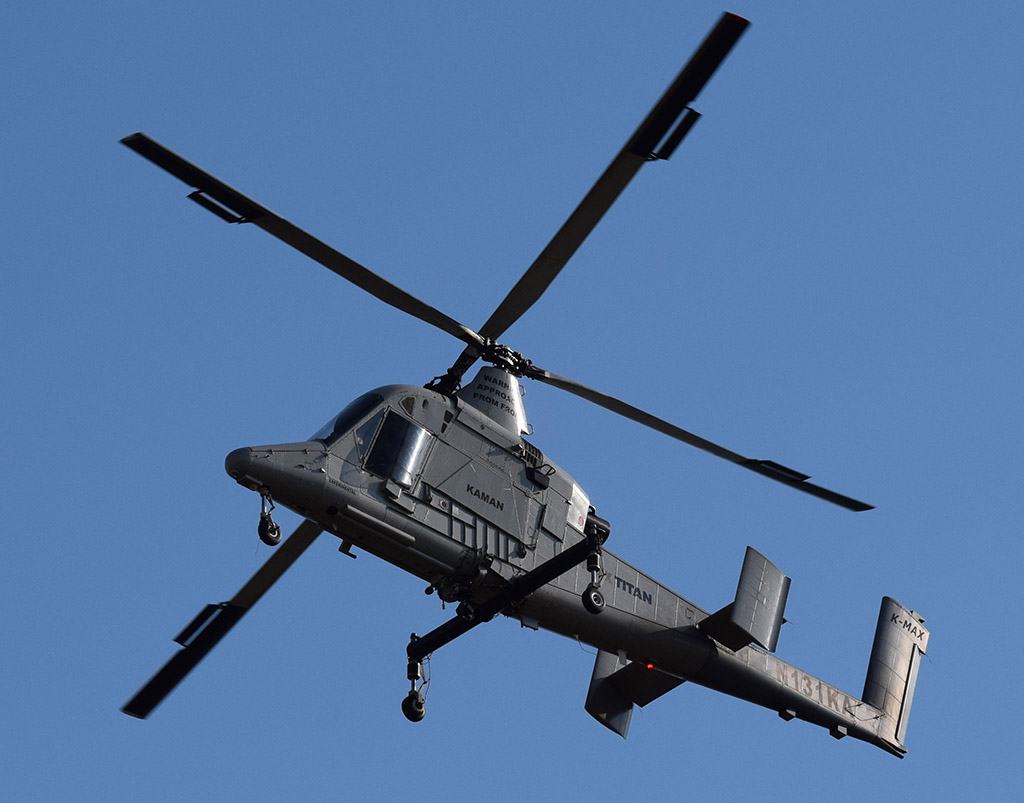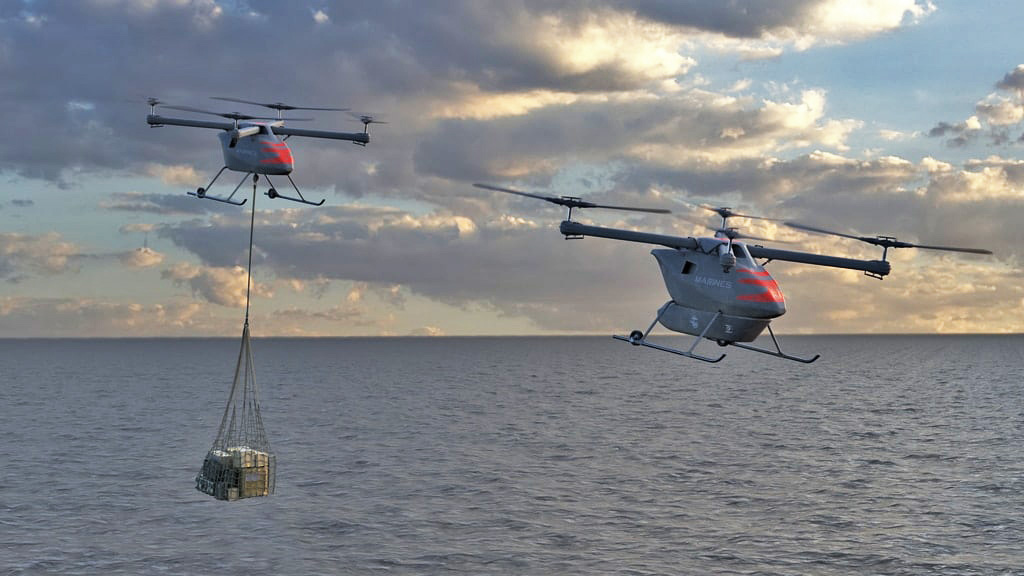
Since Kaman designed, built, and flew in 1957 the first-ever unmanned helicopter, the company’s interest in unmanned aerial vehicles (UAVs) has carried over into the 21st century. This year the company introduced two more UAVs, a medium and a heavy lift helicopter.
Between 2001 and 2014 two Kaman K-MAX helicopters converted to UAVs capable of autonomous or remote controlled cargo delivery transported thousands of loads of supplies and equipment to soldiers in Afghanistan. They carried more than 1.5 million pounds of cargo, sometimes through areas that would be considered unacceptably risky for human pilots. Typically operating at night, these unmanned missions replaced the equivalent of 900 convoy vehicles and eliminated 46,000 hours of exposure time to IED’s, direct fire, and other threats to our troops on dangerous roads.

Kaman is making a new K-MAX TITAN system which will be available on new production K-MAX helicopters or to retrofit existing K-MAX ships. The system made its initial flight April 21, 2021 of what the company calls the world’s first heavy lift unmanned helicopter for the commercial market. The aircraft can lift up to 6,000 pounds which translates to about 700 gallons of water in an external bucket.
“Kaman leads the way with innovative solutions for our customers that are reliable, affordable and sustainable. K-MAX TITAN is no exception, whether the mission calls for firefighting, humanitarian assistance, or distributed logistics,” stated Darlene Smith, President, Air Vehicles and Precision Products Divisions.
Kaman also has a contract with the U.S. Marine Corps to upgrade the autonomous capabilities of their two USMC K-MAX helicopters.
The other Kaman UAV introduced this year is the KARGO UAV. Built with the U.S. Armed Forces future operating concepts in mind, the KARGO UAV offers a rugged design for easy transport and deployment. The system’s compact form-factor fits in a standard shipping container and is designed to be unloaded and operated by as few as two people.
“The Kaman KARGO UAV is the only system of its class that is purpose-built to provide deployed Marines, Sailors, Airmen, Soldiers, and Coast Guard autonomous resupply in the lethal, fluid combat environment that future military operations will entail or for regular logistics missions. Our deployed service men and woman have persistent logistics challenges that we are answering with this reliable, maintainable and affordable solution,” said Ian Walsh, CEO of Kaman Corporation.
The company says the vehicle also has multiple commercial applications.
Designed to provide cost-effective cargo hauling in its conformal pod or external sling load configuration, the KARGO UAV will self-deploy with no payload up to 602 miles with a maximum lifting capacity of 800 pounds. It should be able to haul approximately 90 gallons of water in an external bucket.
In September, 2021, flight development testing of a scaled KARGO UAV demonstrator was completed to prove out the air vehicle design, and flight-testing of a full-scale autonomous vehicle is planned for 2022. The KARGO UAV leverages commercial off-the-shelf components as well as thousands of hours of automated and autonomous flight data from Kaman’s K-MAX TITAN program, to reduce schedule and technical risk.
Kaman worked with Near Earth Autonomy as a partner to provide obstacle avoidance and other technologies such as precision landing, sense and avoid, and navigation in a GPS-denied environment.
In 2015 near Boise, Idaho Kaman and Lockheed demonstrated for wildland fire officials how a remotely piloted K-MAX UAV could drop water on a simulated fire and carry sling loads of cargo.
Our take:
We have written quite a bit recently about new UAVs, because there is a great deal of iteration and activity in the field. Some of the aircraft are already flying and others are still in the concept stage. Not all of them will take to the air or be used in a meaningful way. However, the interest in UAVs combined with limited numbers of firefighters, advances in technology, and increasing wildland fire acres produces an environment ripe for being exploited by nimble forward-thinking companies.
It appears likely that in the near future UAV helicopters will assist wildland firefighters not only by dropping water on fires but by resupplying them in remote areas with food, drinking water, hose, water tanks, and portable pumps — day or night. Already they are used for mapping, real time intelligence, and aerial ignition.
The limiting factor is government funding, and how quickly the old guard fire hierarchy can adapt their thinking to pilotless aircraft and flying at night.
Thanks and a tip of the hat go out to Gerald.

I am curious how much these UAV’s cost, as you mentioned a limiting factor is “government funding”. I am also curious about the potential for operating in adverse weather conditions (high, variable winds). It seems they may have conquered the limited visibility conditions, but I don’t see much mention of performance in adverse weather conditions.
WOW! As a certified “old guy” that used to helijump out of a Bell 3B1, this is amazing technology.